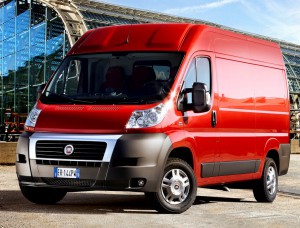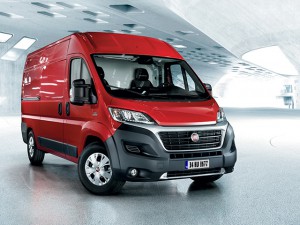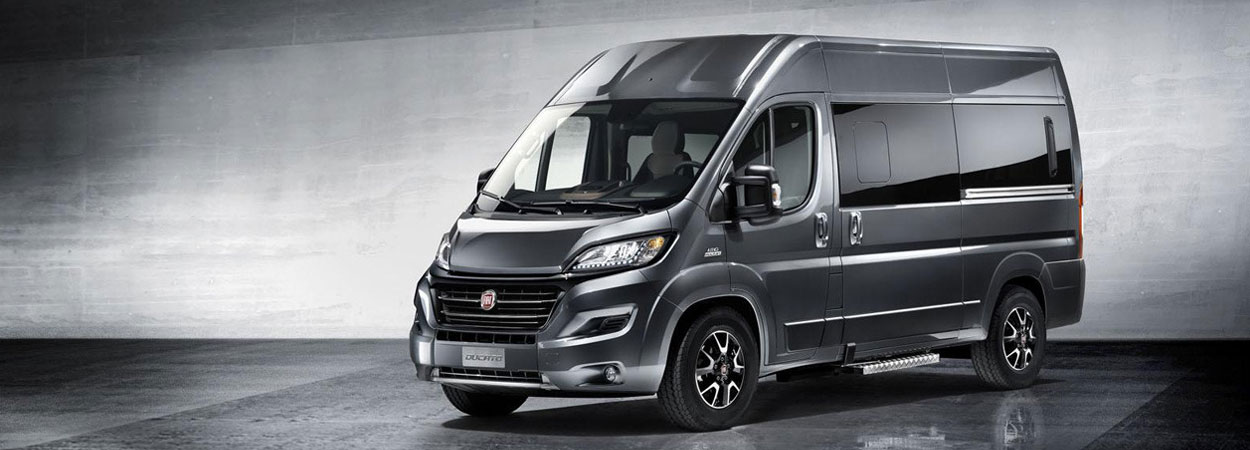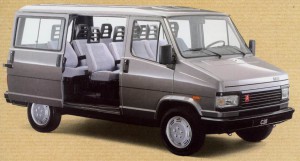Fiat Ducato
The Fiat Ducato is a light commercial vehicle developed by the Sevel joint venture between Fiat and PSA Peugeot Citroën, produced since 1981. It was also sold as the Citroen C25, Peugeot J5, Alfa Romeo AR6 and Talbot Express for the first generation while the second and third generations were marketed as Fiat Ducato, Citroën Jumper, Peugeot Boxer and as the Ram ProMaster for the third generation US and Canada market starting in 2013. In Europe, it is produced at the Sevel Sud factory, in Val di Sangro, Italy. It has also been produced at the Sevel factory in Sete Lagoas, Brazil, at the Karsan factory in Akçalar, Turkey, at the Lotus factory in Iran, at the Chrysler factory in Saltillo, Mexico, and at the Sollers factory in Elabuga, Russia.
Since 1981, more than 2.6 million Fiat Ducatos have been produced. The Ducato is the most common motorhome base used in Europe; with around two thirds of motorhomes using the Ducato base.
First Generation (1981–1993)
 The Ducato was first launched in 1981 and was the result of Fiat’s collaboration with PSA Peugeot
The Ducato was first launched in 1981 and was the result of Fiat’s collaboration with PSA Peugeot
Citroën that resulted in the vehicle’s development starting in 1978. The vehicles were manufactured at the Sevel Val di Sangro plant in Atessa, central Italy, together with the similar Alfa Romeo AR6, Citroën C25 and Peugeot J5 versions. The Peugeot J5 was sold as the Talbot Express in the United Kingdom (1986–1994). The collaboration of Fiat and PSA had earlier produced the Fiat 242 and Citroën C35 from 1974.
For the Fiat, engines were 2.0-litre 4-cylinder petrol or 1.9 diesel. Trim levels were base, S and SX. Model variants were named according to carrying capacity: Ducato 10 (1.0 tons), Ducato 13 (1.3 tons), Ducato 14 (1.4 tons) and Ducato Maxi 18 (1.8 tons). The Ducato Mk1 was very popular as a basis for campervan conversions. A short-wheelbase version was sold as Fiat Talento.
Alfa Romeo AR6
The Alfa Romeo AR6 was a badge engineered Ducato sold by Alfa Romeo on the
Italianmarket only. It was available in two different wheelbase lengths, and as passenger van, commercial van or pick-up truck.
Citroën C25
The Citroën C25 was a 2.5 tonne capacity van (hence the name C25) produced from
October 1981 until 1993. The C25 succeeded the dated corrugated Citroën Type H post war one tonne van. The C25’s engines are transversely mounted; the petrol one is a Peugeot 504 unit whilst the diesel one is from the Citroën CX diesel. Both units are coupled to a Citroën gearbox.In February 1982, the range was extended to include a pick up truck and a minibus. In 1991, the C25 series 2 was launched with an enlarged grille. In 1994, the C25 was replaced by the Jumper.
Peugeot J5
The Peugeot J5 was a 2.5 tonne capacity van, produced from October 1981 until 1993. Itspowertrains are as per the Citroën C25. In 1991, the J5 series 2 was launched with a new front grille and headlights. It was replaced in 1994 by the Peugeot Boxer (based on the second generation Fiat Ducato).
It sold reasonably well in France but enjoyed little commercial success outside France, being overshadowed in much of Europe by the Fiat Ducato which was supported by stronger commercial vehicle dealership networks in key markets.
Talbot Express
The Talbot Express van, sold solely in the United Kingdom, was the last Talbot motorvehicle to be produced. Production of this badge-engineered UK version of the Peugeot J5 began in 1982 and continued until 1994, nearly eight years after the last Talbot badged passenger car had been withdrawn.
Its Citroën/Peugeot petrol and diesel engines are transversely mounted driving the front wheels. A 4×4 option was also available although now very rare.
In 1991, the series 2 Express was launched with an enlarged grille. Production was discontinued in 1994, when Peugeot finally discarded the Talbot marque.
This van was popular in the UK for new conversions to camper vans or motorhomes by coach-builders. Provided they are well maintained and not too rusty they can still command prices of many thousands of pounds even though they are more than twenty years old. This is in marked contrast to the values of the commercial van versions.
Second Generation (1993–2006)
 New Sevel produced version. Peugeot called it Boxer while Citroën named it Jumper (Relay in the UK). One engine option was a Fiat 2.5 L diesel, which was replaced with 2.8 L Iveco/Sofim engine in 1998.
New Sevel produced version. Peugeot called it Boxer while Citroën named it Jumper (Relay in the UK). One engine option was a Fiat 2.5 L diesel, which was replaced with 2.8 L Iveco/Sofim engine in 1998.
The Ducato Goods Transport has a payload of 12 m cubed and comes with a choice of four engines: the 2.0 petrol, 2.0 JTD, 2.3 JTD 16v or 2.8 JTD. All of these conformed to the Euro 3 standards and offered programmed maintenance management. The range included two types of gearbox: a mechanical box with a five-speed manual plus reverse and an automatic transmission with four speeds plus reverse.
The Ducato Passenger Transport has a carrying capacity of 6 to 9 people and comes with the 2.3 litre JTD 16v engine, which again is Euro 3 compliant and delivers 110 bhp.
The Ducato Combi is a mixture of the Goods Transport and the Passenger Transport. It is ideal for the transport of people and goods alike, and it can accommodate up to 9 occupants. Model designations were Ducato 10 (1 ton), Ducato 14 (1.4 tons) and Ducato Maxi 18 (1.8 tons).
Second series was restyled in 2002 with the addition of rear and side bump mouldings and revised front grille. The engine range was: 2.0 JTD, 2.3 JTD 16v and 2.8 JTD, 2.5 diesel was dropped. Model designations were changed to reflect maximum gross weight: Ducato 29 (2.9 tons), Ducato 30 (3.0 tons), Ducato 33 (3.3 tons) and Ducato Maxi 35 (3.5 tons).
This generation is now being produced in Brazil, in Iveco plant, in Sete Lagoas, and in Russia since 2006 in Elabuga town.
Third generation (2007–2014)
 The third generation Jumper/Relay was launched in May 2006, followed by the Boxer in June and
The third generation Jumper/Relay was launched in May 2006, followed by the Boxer in June and
the Ducato later that year. The vehicle was available in many variants both for people and goods transport. Weights were again increased, with the following designations for all-up weight: Ducato 30 (3 tonnes), Ducato 33 (3.3 tonnes), Ducato Maxi 35 (3.5 tonnes) and Ducato Maxi 40 (4 tonnes).
Peugeot Manager
This third generation Ducato has been available in Mexico since November 15, 2007, and over 30 different models are available.As part of the joint venture between PSA Peugeot Citroën and Fiat Group, the Peugeot version of the Fiat Ducato, known as Boxer in Europe, is also available in Mexico, but with the “Manager” nametag.
Ram ProMaster
On February 7, 2013, Ram Commercial Trucks (part of Chrysler Group’s Ram Trucks brand) unveiled the Ram ProMaster at the Chicago Auto Show. Since the 2009 bankruptcy of Chrysler and subsequent acquisition by Fiat, Chrysler has not offered a large van in the United States or Canada. Dodge Trucks (the brand name used by Chrysler prior to the inception of the Ram brand) had offered a version of the Mercedes-Benz Sprinter van starting in 2003, and earlier the Dodge Ram Van.Based on the Ducato, the most significant difference between the ProMaster and the Ducato is the availability of a 3.6L 24-valve V6 gasoline Chrysler Pentastar engine offered in conjunction with the Chrysler 62TE six-speed automatic transmission as standard equipment. The Iveco 3.0L 16-valve L4 diesel JTD engine, branded as the EcoDiesel by Chrysler, mated with the M40 six-speed automated manual transmission is offered as an optional powertrain.
The ProMaster is offered in three wheelbases (118-inch (3,000 mm), 136-inch (3,500
mm), 159-inch (4,000 mm)), four overall body lengths (195-inch (5,000 mm), 213-inch (5,400 mm), 236-inch (6,000 mm), 250-inch (6,400 mm), with the two longest body lengths available only with the 159-inch (4,000 mm) wheelbase), and two overall heights (88-inch (2,200 mm) and 99-inch (2,500 mm)). The panel-van configuration is available in all sizes, while the chassis-cab and cut-away configurations are offered only in 136-inch (3,500 mm) and 159-inch (4,000 mm) wheelbases. The window-van is available only in the 159-inch (4,000 mm) wheelbase and 99-inch (2,500 mm) roof height. The ProMaster is produced in Chrysler’s manufacturing facility in Saltillo, Mexico, and was first available in October 2013.
Types of body configurations
Cargo Van: This is the standard configuration of the ProMaster. This configuration is usually used for delivery and sometimes for outside broadcasting. It is also the standard model for ambulances. It is available in all sizes.Window Van/Glazed Van: Unlike most full-size vans, which have seats already installed for passenger use when they are sold, the ProMaster window or glazed van does not have rear seats. However, it can be converted into a passenger van before or after sale. Buyers and dealers choose the configuration for the van. It can be configured for personal, shuttle, taxi, school bus, church bus, or hotel bus use. It can also be used as a law enforcement transporter. It also can be used as a cargo van The window van is only available as a high-roof model with a size configuration of 2500.
Chassis-Cab: The chassis-cab is used as a flatbed truck and a box van. The box van can be used as a street vending van, an ambulance, or a delivery van. It is available in all sizes.
Cut-Away: Cutaway van chassis versions are traditionally used for motor homes. It is available in all sizes.
Passenger Van: Ram currently does not manufacture a passenger van for the full-size van segment. However, it is estimated that version of the Promaster will reach dealerships in North America in early fall 2014. This model will be originally be used as a limo. It could also be used as a family van. While the Promaster passenger van will come in different sizes and roof configurations, the default version of this van is 3500.
Fourth Generation (2014–) “Facelift”
 The fourth generation Ducato/Jumper/Relay/Boxer was announced in May 2014. Although based on the third-generation model, it features a heavily revised front-end with more car-like headlight styling.
The fourth generation Ducato/Jumper/Relay/Boxer was announced in May 2014. Although based on the third-generation model, it features a heavily revised front-end with more car-like headlight styling.


